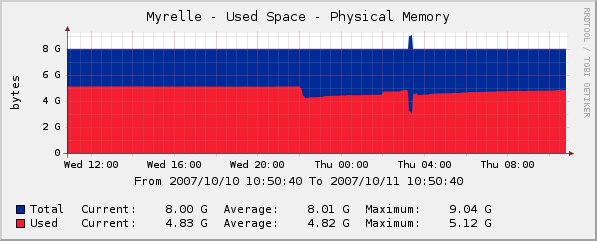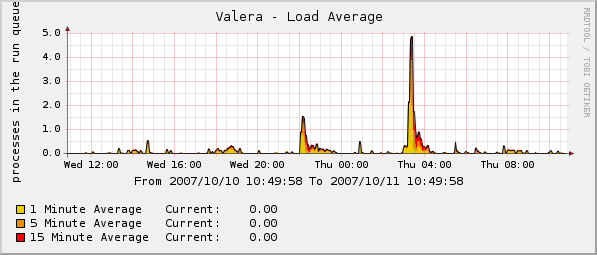I’ve finally gotten around to getting a new computer; an XPS M1710 with a 2.33GHz Core 2 Duo processor, 2GB RAM, and a GeForce 7950 Go GTX (512MB RAM). It’s been working fairly well so far performance-wise (and with dual core, my computer was even responsive during VS2005SP1 setup!). There were a couple of nice unexpected upgrades that I happened to get in the process; the new laptop has a built-in smart card reader (good-bye clunky USB smart card reader), and the LCD backlight brightness is much improved over my Inspiron 9300 (a relatively dim backlight and a glossy display made that laptop difficult to read sometimes, depending on outside lighting conditions). Also, the programmatic LCD brightness API seems to be functional with the new video card (I’ve got some plans for that, primarily relating to replicating the neat MacBook Pro behavior of automatically dimming the display when idle – assuming no program has put the system in contiguous display mode, like with video playback or slideshow presentations).
Having a dual core chip on my main workstation is definitely a noticible benefit for me; the difference is immediately visible when running two intensive programs at the same time (which is a common occurance for me, a multimon addict). If you do serious multitasking on one computer, then you’re a prime candidate for seeing real benefit from dual core, in terms of keeping the system responsive while running more than one intensive program simultaneously (provided your programs aren’t all I/O-bound).
Perhaps the most fundamental change, however, is that I decided to go with Windows Vista x64 as the operating system. This means that for all general-purpose computing, I am effectively cutting over to a 64-bit platform entirely (in the past, I’ve only really used x64 for development and not as a general-purpose platforms). This includes the whole gamut, from development and debugging to games and email and whatnot. I’ve already tried Vista out as the operating system on my primary workstation before and it worked out well enough, but taking the leap to 64-bit is another story entirely. Since there’s no backwards compatibility with 32-bit drivers, this is a bit more of a change than just switching to Vista as far as having working hardware goes.
It turned out that things ended up much better than I thought, however. Vista ended up shipping with native x64 drivers for almost all of my hardware (even the Bluetooth 2.0 card and draft 802.11n WLAN card – seems the people at Broadcom have been busy working on their drivers lately). The only hardware that didn’t have native drivers out of the box were several of the non-SD memory card reader devices (i.e. Picture Card), which I don’t really happen to care about, and the video card. Getting the video card to work was a bit of a hassle; I first grabbed NVIDIA’s latest official Vista x64 beta drivers (release 96.85), but these turned out to be fairly buggy (strange graphical corruption in fullscreen mode in Neverwinter Nights 2). Eventually, I dug up a copy of some more recent Vista x64 drivers (release 97.46) which were a bit more stable (unfortunately, I had to go manually install the drivers as the inf didn’t properly list my card as supported). That little bit of unpleasantness aside, the Vista x64 experience has been pretty good so far. World of Warcraft and Neverwinter Nights 2 run fine under Wow64, and all of the usual development tools (VS2005 and friends) work as well, though I had prior experience getting VS2005 working under Windows Server 2003 x64.
The only piece of hardware that I’m still not sure about on the new laptop is the ExpressCard slot (which might be what the Ricoh 1180:0843 device that I haven’t been able to identify is). I don’t see this as an immediate problem, however; the only generally available ExpressCards that I have seen thus far are EVDO/EDGE/HSDPA modems, and as Bluetooth works out of the box, I can get EVDO/1x modem capability just fine using my cell phone instead of through a dedicated ExpressCard modem.
While there have been a couple of rough edges (having to manually override PnP for installing new video card drivers, and a couple of installers that were confused about the difference between c:\windows\system32 and c:\windows\syswow64), it seems that native x64 Windows support on real hardware (as opposed to just running in VMs) has come a long way recently. If you are thinking about trying x64 Windows outside of a VM, though, I would try to make sure that you have relatively recent hardware. Since you won’t be able to rely on backwards compatibility with old 32-bit drivers released that may have been released many years ago, any hardware vendors that have provided you hardware will in general need to have been still actively supporting that hardware relatively recently for there to be a shot at it having x64 drivers.
All in all, things look good so far with the new hardware (and running everything under x64). I’ll post back with any showstoppers I encounter with doing x64 full-time, but things are looking well thus far.

